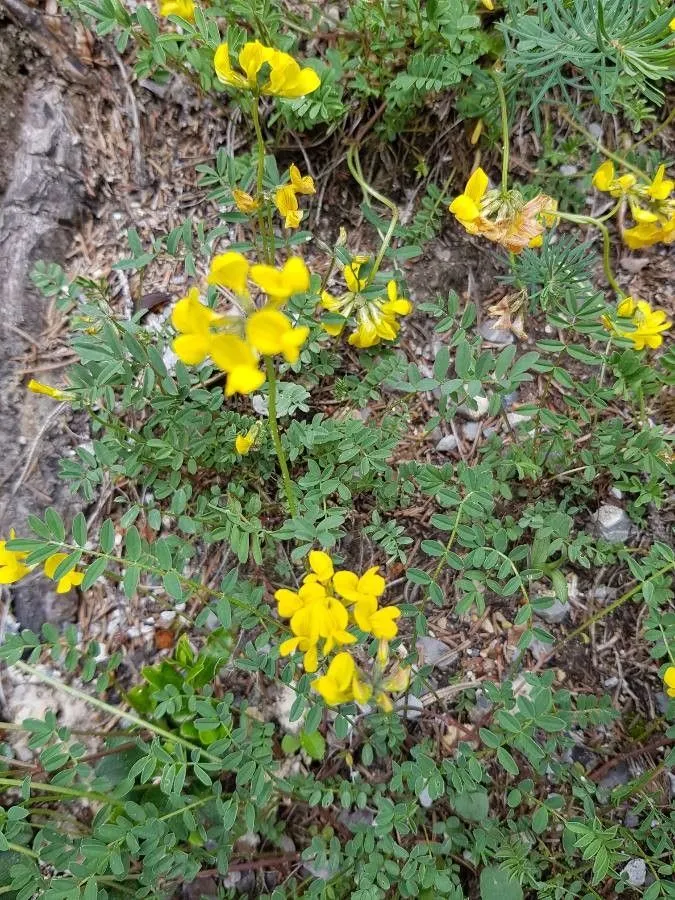
Author: Lam.
Bibliography: Encycl. 2: 121 (1786)
Year: 1786
Status: accepted
Rank: species
Genus: Coronilla
Vegetable: Unknown
Observations: C. & SC. Europe
The Small scorpion-vetch, scientifically known as Coronilla vaginalis, is a perennial herbaceous plant belonging to the family Fabaceae. This intriguing species has a notable presence predominantly across Central and Southern Europe.
Characterized by its delicate, fine-structured foliage, the Small scorpion-vetch thrives in a variety of habitats, often preferring well-drained soils and sunny locales. It is a resilient plant, adapting to both calcareous and slightly acidic soils. The leaf arrangement is typically pinnate, contributing to the plant’s overall feathery and elegant appearance.
One of the most distinctive features of Coronilla vaginalis is its vibrant yellow flowers, which bloom in clusters. These blossoms are not only aesthetically pleasing but also play a crucial role in the ecosystem by attracting a range of pollinators, including bees and butterflies. The flowering period spans from late spring to early summer, during which the plant offers a stunning display of color against the greenery.
In addition to its ornamental appeal, the Small scorpion-vetch is noteworthy for its nitrogen-fixing capabilities. Like other members of the Fabaceae family, it forms a symbiotic relationship with Rhizobium bacteria, enriching the soil with nitrogen and thereby enhancing soil fertility. This attribute makes Coronilla vaginalis a valuable species for sustainable gardening and ecological restoration projects.
Historically, the species was first described in 1786 by the renowned botanist Jean-Baptiste Lamarck, whose work was published in the comprehensive Encyclopédie Méthodique. Since then, Coronilla vaginalis has garnered attention not only for its ecological benefits but also for its utility in traditional medicine, where it has been employed for its purported anti-inflammatory and diuretic properties.
Nonetheless, while often celebrated for its versatility and beauty, Coronilla vaginalis requires minimal maintenance once established. It proves to be a hardy addition to rock gardens, borders, and naturalized areas where it can flourish with minimal intervention. Its adaptability, coupled with its environmental benefits, underscores its significance within the plant kingdom.
In conclusion, Coronilla vaginalis, the Small scorpion-vetch, stands out as a plant of both ecological and ornamental value. Its contribution to soil health, coupled with its striking yellow flowers, ensures its place as a cherished species within the rich tapestry of Europe’s flora.
Deu: scheiden-kronwicke
En: Small Scorpion-vetch
Nl: Schedekroonkruid
Fr: Coronille Engainante, Coronille à stipules engainantes, Coronille engainée
De: Scheiden-Kronwicke, Umscheidete Kronwicke
It: Cornetta guainata
Taken Jul 30, 2012 by Tela Botanica − Jean-Luc Gorremans (cc-by-sa)
Taken Mar 18, 2017 by Yoan MARTIN (cc-by-sa)
Taken Mar 18, 2017 by Yoan MARTIN (cc-by-sa)
Taken Jun 18, 2016 by Tela Botanica − Yoan MARTIN (cc-by-sa)
Taken Mar 18, 2017 by Yoan MARTIN (cc-by-sa)
Taken Aug 15, 2001 by Photoflora – Benoit BOCK (©)
Taken Aug 15, 2001 by Photoflora – Benoit BOCK (©)
Taken Jan 1, 1800 by Tela Botanica − Thierry Pernot (cc-by-sa)
Taken Mar 18, 2017 by Yoan MARTIN (cc-by-sa)
Taken Aug 25, 2018 by Christophe Lo (cc-by-sa)
Taken Jul 14, 2021 by Anne-Evelyne Vallet (cc-by-sa)
Taken Jun 18, 2016 by Tela Botanica − Yoan MARTIN (cc-by-sa)
Taken Jun 18, 2016 by Tela Botanica − Yoan MARTIN (cc-by-sa)
Taken Jun 18, 2016 by Tela Botanica − Yoan MARTIN (cc-by-sa)
Taken Jun 18, 2016 by Tela Botanica − Yoan MARTIN (cc-by-sa)
Taken Jun 18, 2016 by Tela Botanica − Yoan MARTIN (cc-by-sa)
Taken Jun 18, 2016 by Tela Botanica − Yoan MARTIN (cc-by-sa)
Taken Jun 18, 2016 by Tela Botanica − Yoan MARTIN (cc-by-sa)
Taken Jun 22, 2019 by Christophe Bourdillon (cc-by-sa)
Taken Jan 1, 1970 by Photoflora – L’Abbé COSTE (©)
Taken Jul 15, 1987 by Photoflora – Jean-Luc TASSET (©)
Taken Jul 15, 2018 by Photoflora – Benoit BOCK (©)
Family: Myrtaceae Author: (F.Muell.) K.D.Hill & L.A.S.Johnson Bibliography: Telopea 6: 402 (1995) Year: 1995 Status:…
Family: Rubiaceae Author: Pierre ex A.Froehner Bibliography: Notizbl. Bot. Gart. Berlin-Dahlem 1: 237 (1897) Year:…
Family: Sapindaceae Author: Koidz. Bibliography: J. Coll. Sci. Imp. Univ. Tokyo 32(1): 38 (1911) Year:…
Family: Asteraceae Author: A.Gray Bibliography: Pacif. Railr. Rep.: 107 (1857) Year: 1857 Status: accepted Rank:…
Family: Fabaceae Author: Medik. Bibliography: Vorles. Churpfälz. Phys.-Ökon. Ges. 2: 398 (1787) Year: 1787 Status:…
Family: Aspleniaceae Author: (Cav.) Alston Bibliography: Bull. Misc. Inform. Kew 1932: 309 (1932) Year: 1932…